ВУЗ: Казахская Национальная Академия Искусств им. Т. Жургенова
Категория: Книга
Дисциплина: Не указана
Добавлен: 03.02.2019
Просмотров: 17280
Скачиваний: 51
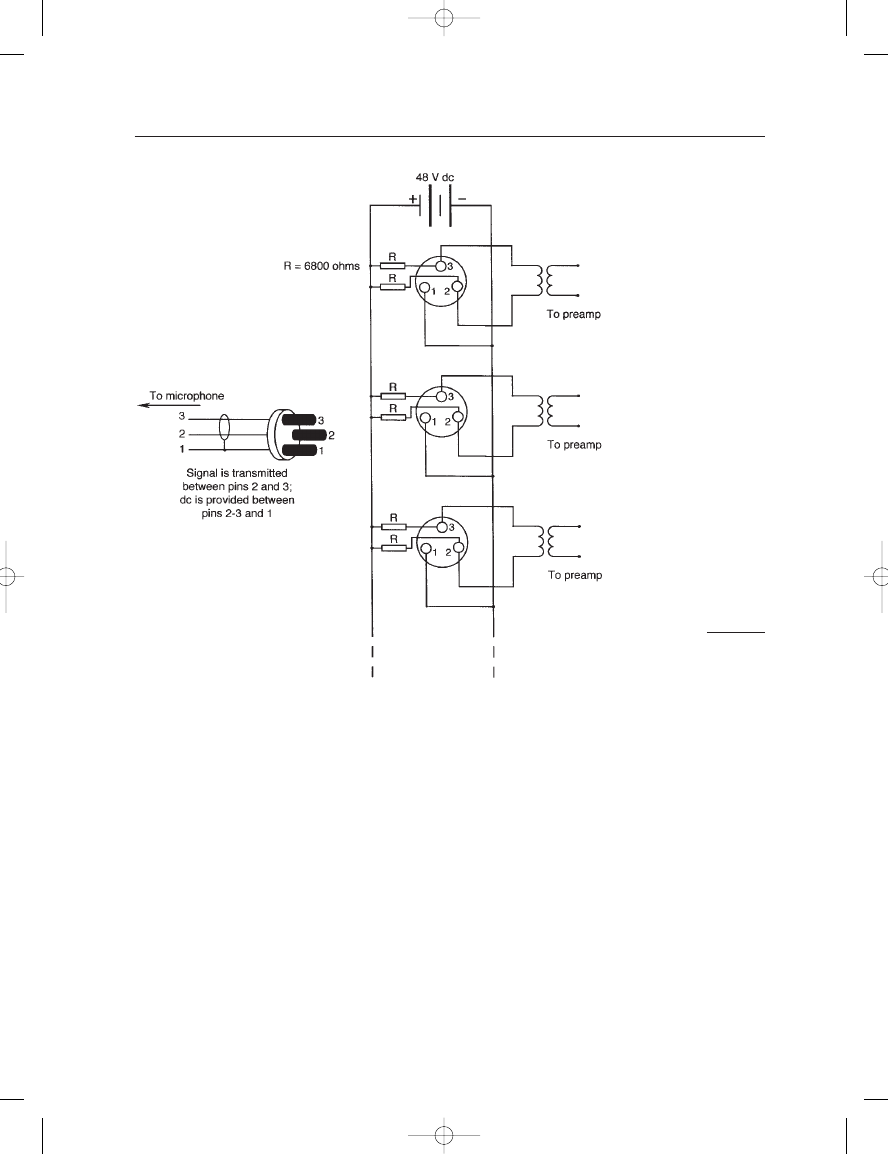
If the microphone has an integral output transformer, then a center-
tapped secondary winding is used for receiving the positive voltage. This
method is shown in Figure 8–2B. Phantom powering can also be used
when there is neither a microphone output transformer or a console
input transformer, as shown in Figure 8–2C.
Phantom powering at 48 V is normally designated as P48. There are
also standards (IEC publication 268-15) for operation at nominal values
of 24 V (P24) and 12 V (P12). Voltage tolerances and current limits for
the three standards are shown in Table 8–1. The resistor values are
generally held to tolerances of 1%.
T-powering (also known as A-B powering) is rarely encountered
today. Circuit details are shown in Figure 8–3. It is normally designated
as T12. T-powering is a holdover from earlier years and still may be
encountered in motion picture work, where it is built into the many
Nagra tape recorders used in that field. Here, the audio signal leads are
at different dc voltages, and any residual hum or noise in the dc supply
will be reflected through the microphone’s output as noise.
THE MICROPHONE BOOK
118
FIGURE 8–1
Basic circuit for phantom
(simplex) powering.
Earg_08.qxd 14/9/04 2:45 PM Page 118
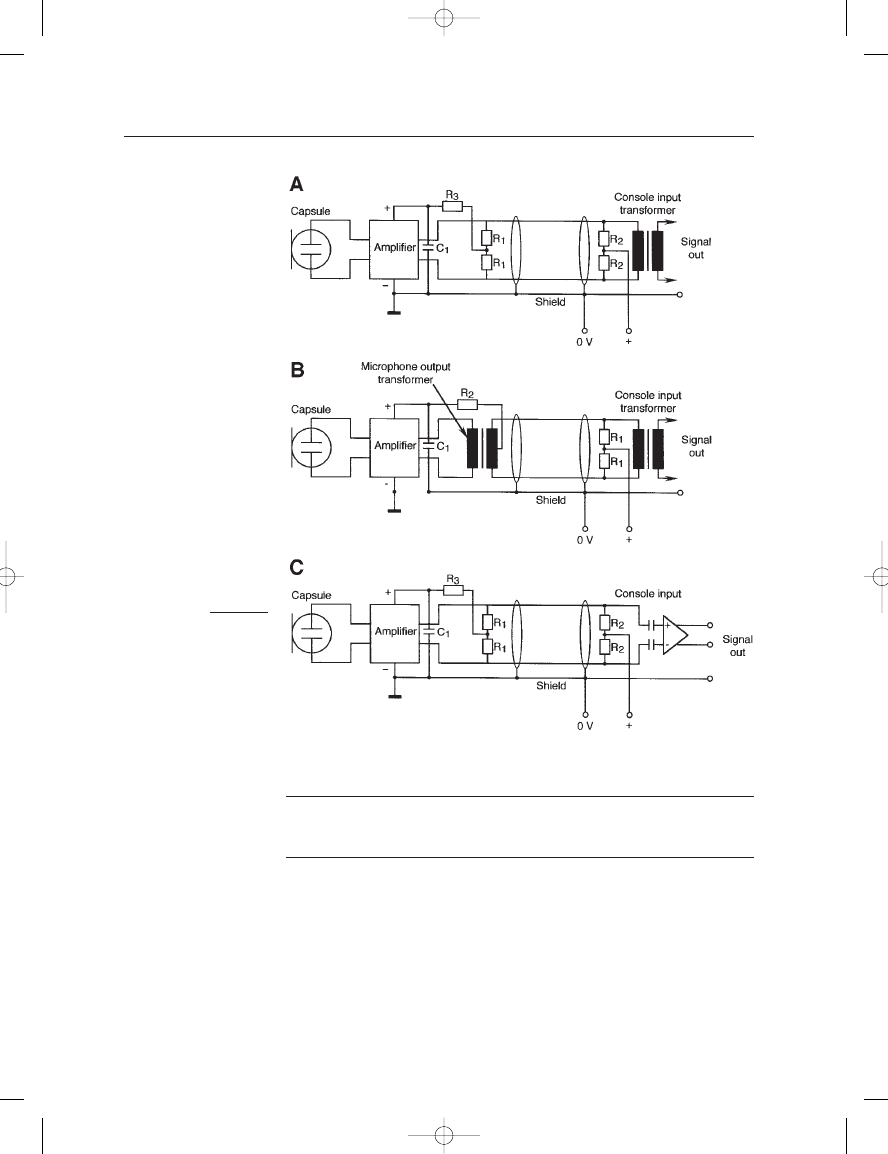
USING PHANTOM POWERING
Most microphone preamplifiers and console input sections have provision
for individual switching of phantom power on or off. When using dynamic
microphones it is good engineering practice to turn off the phantom pow-
ering, even though no current will flow through the microphone’s voice
coil should the phantom power be left on. However, if T12 power is
8: Electrical Considerations and Electronic Interface
119
TABLE 8.1
Voltage tolerances and current limits
Supply voltage
12
1 V
24
4 V
48
4 V
Supply current
max. 15 mA
max. 10 mA
max 10 mA
Feed resistors
680
1200
6800
FIGURE 8–2
Microphone power input
circuitry using a resistive
voltage divider (A); using a
center-tapped transformer
secondary (B); using no
transformers in the
powering path (C).
Earg_08.qxd 14/9/04 2:45 PM Page 119
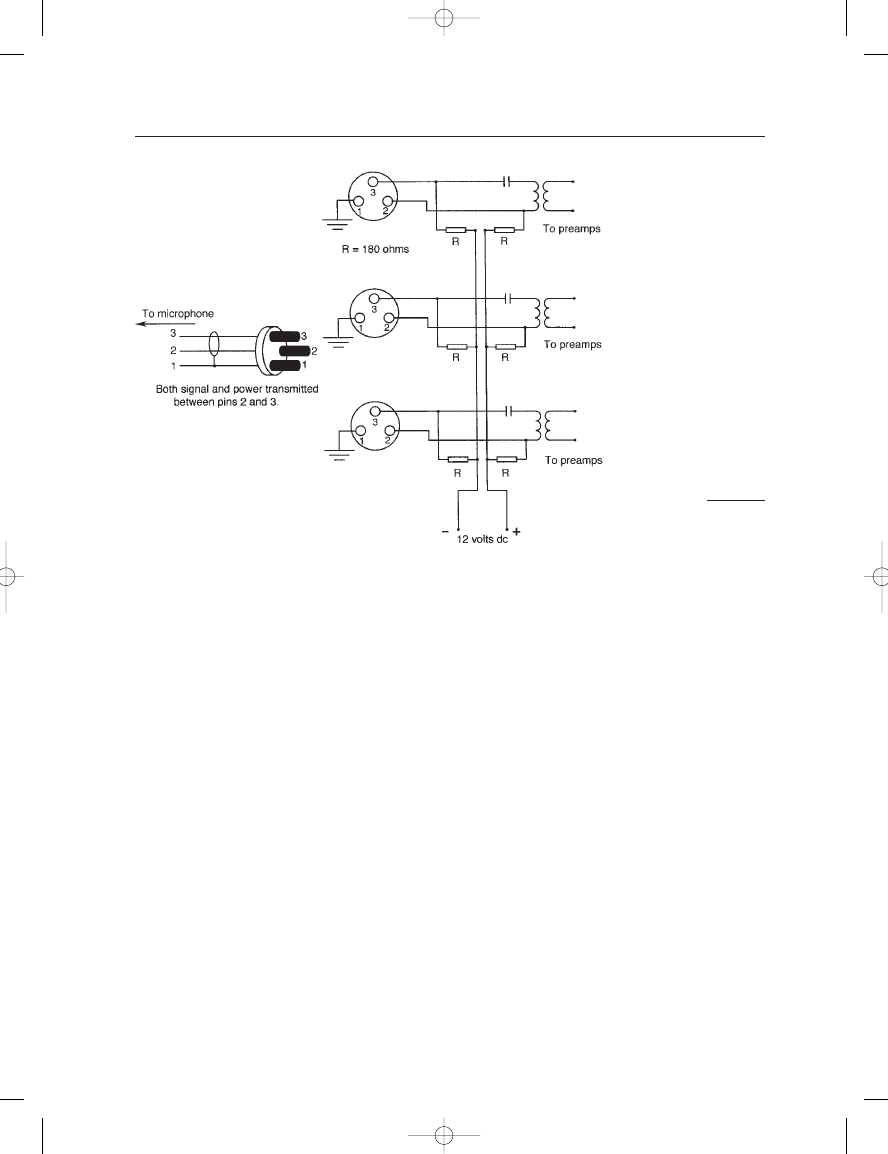
inadvertently applied to a dynamic microphone, the 12 V dc will appear
across the microphone’s voice coil with noticeable deterioration of
response and possible damage.
Another important rule is not to turn phantom power on or off
when a microphone is bussed on and assigned to the monitor channels.
The ensuing loud “pop” could easily burn out a HF transducer in the
monitor loudspeaker systems. At the end of a session, it is normal prac-
tice to reduce both the master fader and the monitor level control to zero
before shutting down all phantom power from the console.
While on the subject of phantom power, never attempt, when phan-
tom power is on, to remove or replace the screw-on capsule that many
capacitor microphones have. This has been known to burn out the FET
in the input circuitry of the impedance converter.
Capacitor microphones vary in their susceptibility to shifts in nominal
voltage in phantom powering. Generally, the variation is on the low side,
such as may be encountered in very long microphone cable runs. Symptoms
may be reduced signal output, increase in noise, as well as distortion.
When these conditions occur with normal cable runs, the round-trip cable
resistance should be measured, and the power supply itself checked for
possible problems.
DC-TO-DC CONVERSION
Some capacitor microphones are designed to operate over multiple
ranges of phantom powering, for example, from 20 to 52 volts dc to
THE MICROPHONE BOOK
120
FIGURE 8–3
Basic circuit for
T-powering at 12 V.
Earg_08.qxd 14/9/04 2:45 PM Page 120
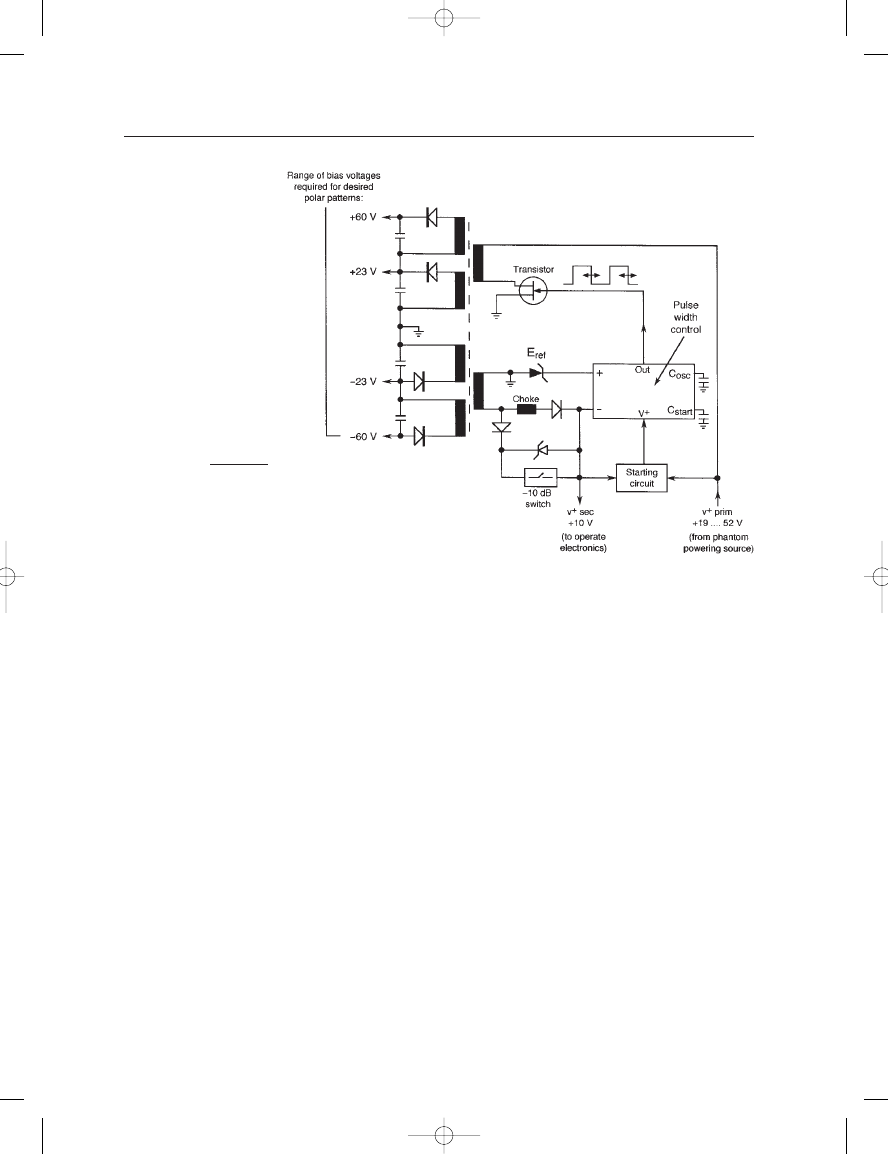
cover requirements of both P24 and P48 powering. What is required
here is a circuit that converts the applied voltage to the value required for
proper biasing of the capsule and operation of the impedance converting
preamp. The circuit for the Neumann TLM107 microphone is shown in
Figure 8–4. A major design challenge in such a circuit is the suppression
of noise that could result from the high switching rate of the input voltage
during the dc-to-dc conversion process.
This circuit provides capsule biasing voltages for its selectable patterns,
reducing them accordingly when the
10 dB pad is engaged. The 10 V dc
output is for powering the microphone’s electronics.
RECENT DEVELOPMENTS IN PHANTOM POWERING
The present standard for phantom powering ensures that 48 V dc in a short
circuit loading condition through two parallel 6800 ohm resistors will pro-
duce a current of 14 mA dc, thus limiting the current availability for a given
microphone model. Some manufacturers have designed microphones that
can accommodate greater current for handling higher sound pressure levels
in the studio, and such microphones require lower resistance values in the
phantom supply in order to receive the higher current. Generally, this has
been carried out in proprietary stand-alone power supplies that a manu-
facturer may provide for a specific new microphone model.
Two-way compatibility is maintained. A new high-current micro-
phone will work on a standard phantom supply, but it will not be able
8: Electrical Considerations and Electronic Interface
121
FIGURE 8–4
Details of dc-to-dc
conversion for microphone
operation at P24 and P48
standards. (Data after
Neumann/USA.)
Earg_08.qxd 14/9/04 2:45 PM Page 121
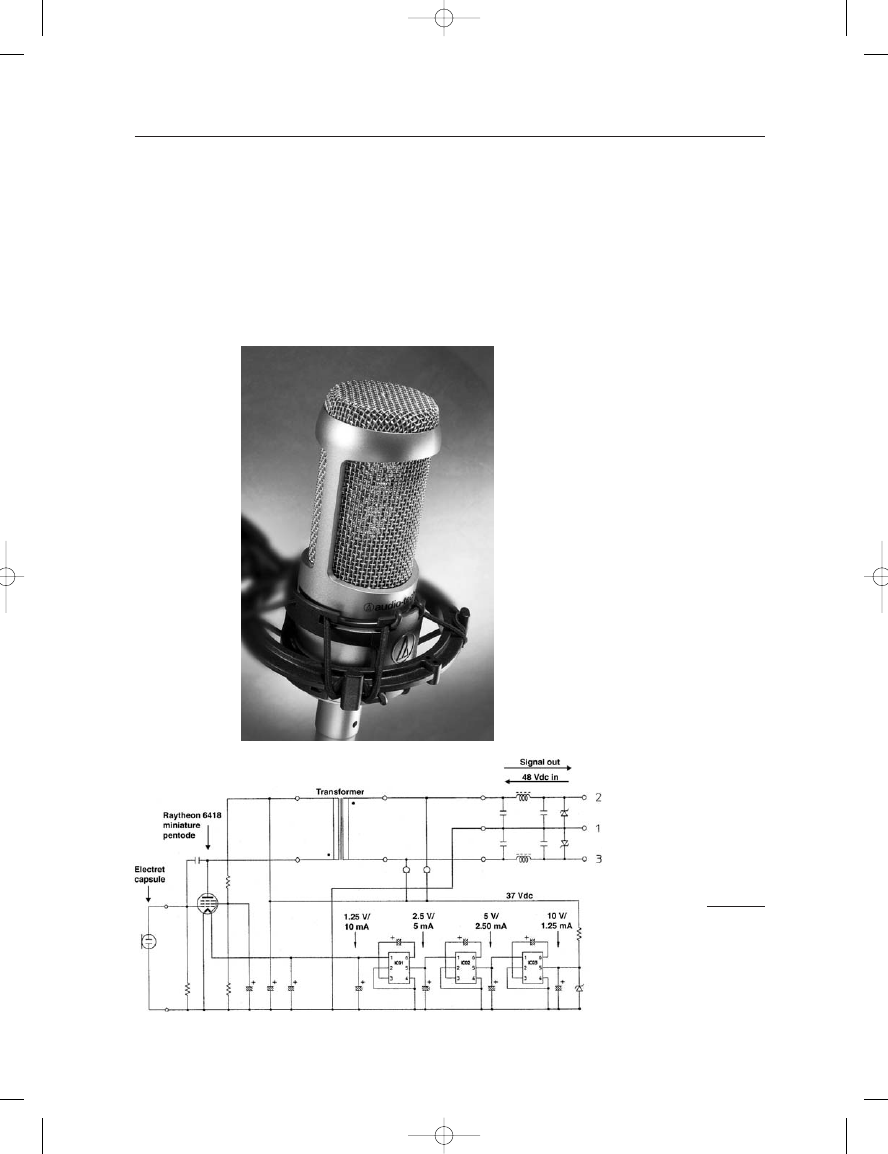
to attain its highest degree of performance. A standard microphone will
work on the new supply, drawing only the current it needs.
Typical here is the “Super Phantom” powering that Josephson
Engineering has specified for certain microphone models, in which current
fed through a pair of 2200 ohm resistors in each leg of the power supply
is directed to the microphone. A short circuit loading condition here would
result in a current draw slightly in excess of 43 mA dc. International stand-
ardization activities are presently under way in this area.
THE MICROPHONE BOOK
122
FIGURE 8–5
The Audio-Technica model
AT3090 microphone;
photo of microphone (A);
circuit details (B). (Data
courtesy of Audio-Technica
USA.)
Earg_08.qxd 14/9/04 2:45 PM Page 122